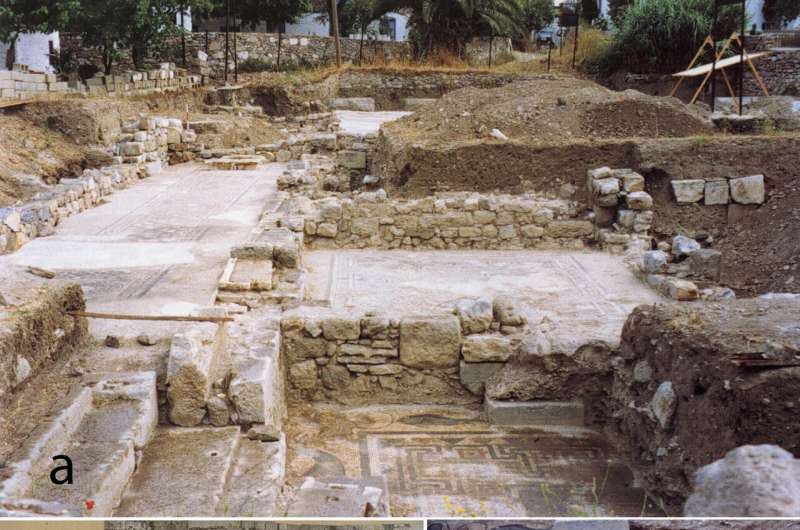Excavation and mosaic floors of villa. Credit: University of Southern Denmark
Although this 1,700-year-old luxury villa was excavated and explored in both 1856 and the 1990s, it still has secrets to reveal.
New secrets have now been revealed by an international research team, with professor and expert in archaeometry, Kaare Lund Rasmussen from the University of Southern Denmark, who leads the so-called archaeometric analysis: by using chemical analysis to determine what elements an object is made of. , how it processes, etc.
Others on the team include Thomas Delbey of Cranfield University in England and classical archaeologists Birte Poulsen and Poul Pedersen of Aarhus University and University of Southern Denmark. The team’s work has been published in the magazine heritage scienceincluding archaeometric analysis of 19, approximately 1,600-year-old mosaic tesserae.
One of the Seven Wonders of the World
The tesserae come from an excavation of a villa from late antiquity, located in Halikarnassos (today Bodrum in Anatolia, Turkey). Halikarnassos was famous for the gigantic and lavish tomb of King Mausolus, which was considered one of the Seven Wonders of the World.
The villa was laid out around two courtyards and the many rooms were decorated with mosaic floors. In addition to geometric patterns, there were also motifs of various mythological figures and scenes from Greek mythology; eg Princess Europa is kidnapped by the god Zeus in the form of a bull and Aphrodite at sea in her seashell.
Selection of the mosaic tesserae, researched by Professor Kaare Lund Rasmussen/ University of Southern Denmark. Credit: Kaare Lund Rasmussen/University of Southern Denmark
Motifs from the stories of the much younger Roman author Virgil are also represented.
Inscriptions in the floor indicate that the owner’s name was Charidemos and that the villa was built in the middle of the fifth century.
An expensive luxury
Mosaic floors were a precious luxury: expensive raw materials such as white, green, black and other marble colors had to be brought in from distant quarries. Other stone materials, ceramics and glass also had to be imported.
“I received 19 mosaic tiles for analysis in my laboratory in Denmark. Of these, seven were made of glass in different colours; purple, yellow, red and deep red. My conclusion is that six of them are probably made from recycled glass,” says Kaare Lund Rasmussen .
This conclusion is based on a chemical analysis called inductively coupled plasma mass spectrometry. The research team has thus determined the concentrations of no fewer than 27 elements, some even down to the billionth of a gram.
Detail of mosaic floor. Credit: Kaare Lund Rasmussen/University of Southern Denmark.
Decline of the Roman Empire – We were able to distinguish between Egyptian base glass and Middle Eastern base glass and also determine which elements had been added by the ancient craftsmen to color and opacify the glasses, which was preferred by the time, he says.
It is of course difficult to extrapolate from just seven glass mosaic tesserae, but the new results fit very well with the image of Anatolia in late antiquity. As the Roman Empire’s power declined, trade routes were closed or diverted, likely leading to shortages of goods in many places, including raw materials for glass production in Anatolia.
This, together with the stories depicted on the floors, allows the classical archaeologists to paint a more detailed picture of what was fashionable in late antiquity and what the possibilities were for the artistic unfolding.
Discovered: unknown yellows from ancient times
Kaare Lund Rasmussen et al, Materials and technology of mosaics from the House of Charidemos in Halikarnassos (Bodrum, Turkey), heritage science (2022). DOI: 10.1186/s40494-022-00697-3
Quote: Floors in ancient Greek luxury villa were laid with recycled glass (2022, July 25) retrieved on July 25, 2022 from https://phys.org/news/2022-07-floors-ancient-greek-luxury-villa.html
This document is copyrighted. Other than fair dealing for personal study or research, nothing may be reproduced without written permission. The content is provided for informational purposes only.

